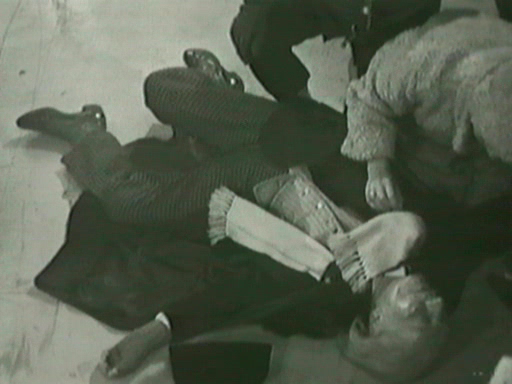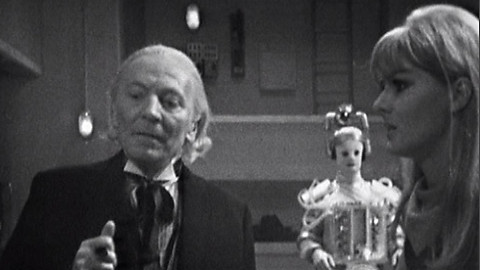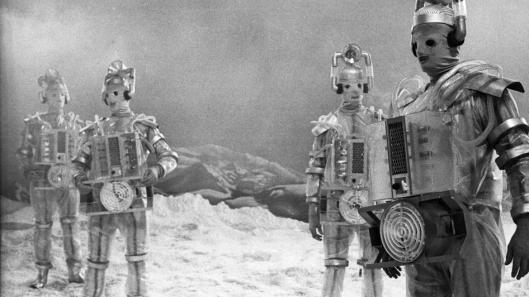by Paul Bowler:
Born in London, 1908, William Hartnell grew up during a dark time of war and social poverty. His admiration for Charlie Chaplin inspired him to become an actor, and in 1926 he got this first job working with Sir Frank Benson’s Shakespearean Company. Further parts in theatre quickly followed, along with small film roles, until his career really took off in 1943 with his memorable role as the army officer in The Way Ahead. Carol Reed’s film opened the doors to numerous film roles for Hartnell, often receiving star billing, but the actor was frustrated by the “tough guy” roles he was always offered, preferring the comedy and farce of his early career.
However, fate would soon intervene when Hartnell’s roles in the Granada TV series The Army Game and Lindsay Anderson’s film, This Sporting Life (1963), led to Verity Lambert considering William Hartnell for the role of the Doctor. The rest, as they say, is history. Over the next three years William Hartnell would help forge the role of the Doctor, a mysterious time traveller, an outcast from his own people, a glorious – if somewhat cantankerous – grandfather from another world. Hartnell adored his time as the Doctor, becoming a hero to millions of children as he took his companions on fantastic adventures in time and space: visiting great historical figures like Marco Polo and King Richard the Lionheart, bizarre aliens like the Zabri and Sensorites appeared with strange cultures and customs, they experienced the futility of trying to alter history and the Aztec civilization in 15th Century Mexico, even turning on each other when the TARDIS drifted towards the edge of destruction, and they were always ready to fight the intergalactic menace of the Daleks which returned time and again. Keeping viewers enthralled as the Doctor valiantly fought them wherever their evil plans of universal domination threatened to destroy every living thing that dared to stand in their way.
Although Doctor Who enjoyed phenomenal success during its formative seasons, as the series entered its fourth year its popularity had begun to wane somewhat, and with new producer Innes Lloyd and story editor Gerry Davis attempting to revitalize the shows format the gruelling schedule sadly began to take its toll on Hartnell who was already in poor health. Once the decision was taken to recast the role of the Doctor it set in motion a chain of events that would not only mark the end of an era, but it would also see the introduction of a new race of monsters whose popularity would go on to rival even that of the Daleks themselves.
So when the TARDIS brought the Doctor, Polly (Anneke Wills), and Ben (Michael Craze) to the South Pole Space Tracking Station under the command of General Cutler (Robert Beatty), viewers would have never imagined how their favourite science fiction series was about to undergo the most crucial metamorphosis of all. In only a few short weeks during October 1966, history would be made as The Tenth Planet was broadcast, and nothing – not even the ever present threat of cancellation – would ever diminish the incredible journey that still endures today as Doctor Who gets ready to celebrate the 50th Anniversary of its unparallel success.
The Doctor arrives at the Tracking Station and discovers that a new planet has entered the solar system, its gravitational pull is threatening a manned space capsule as it approaches, where it is soon revealed to be Earth’s twin planet Mondas. Having been cast adrift in space the people of Mondas turned to cybernetics to prolong their lives, becoming emotionless Cybemen. Now they have returned to replenish their planets recourses by draining energy from Earth and harvesting the population to create the next generation of Cybermen. The Doctor and his friends face a desperate race against time to defeat the Cybermen and prevent General Cutler from launching the deadly Z-Bomb, a weapon that would destroy both worlds. Fortunately Cutler’s plan is thwarted by Ben and Mondas explodes after absorbing too much energy from the Earth, killing all the Cybermen in the process; their bodies disintegrating as soon as they are cut off from their worlds power supply. Ben then rescue the Doctor and Polly from the Cybemen’s spacecraft, but the Doctor appears to be ill, stating that his body is “wearing a bit thin” before rushing back to the TARDIS, where he collapses to the floor as startling transformation begins…
The Cybermen were created in collaboration by Doctor Who’s very own – unofficial – scientific advisor Kit Pedler and story editor Gerry Davis as a possible replacement for Terry Nations incredibly popular Daleks. Pedler envisioned the Cybermen as people who had taken the advances of medical science to the ultimate extreme, replacing their worn out bodies with cybernetic limbs, even computerizing their brains to become nightmarish husks of plastic, metal, and flesh. These creatures are so utterly devoid of emotion that they are no longer even capable of comprehending what it means to be human, as Polly discovers to her horror when she tries to reason with the Cyberman Krail.
With impassive, noseless faces, their bodies adorned with gleaming chest units and lethal energy weapons, these early Cybermen have more than a hint of Mary Shelley’s Frankenstein about them. Like Shelley’s creation they are twisted anachronisms of life, a mutilation of science and gothic themes gone mad in the darkness of interstellar space. In many ways they are far more memorable than their modern counterparts, still clinging to the last vestiges of their humanity, utilizing the formality of individual names even though they no longer have any emotional resonance for them, and going so far as to adopt disguises to infiltrate the Space Tracking Station.
After attacking someone from the Snowcap Base outside the TARDIS, our first close-up of a Cyberman as it turns over Tito’s lifeless body reveals the monsters featureless visage, one that is stretched and distorted beyond anything even remotely human, with dark bulbous eyes and a leathery slit of a mouth. The headpiece is like an elaborate sensor array, with tubes and wires spilling out from the bulky chest unit, while the limbs support and array of cybernetics that end abruptly with cold humanoid hands. The patchwork nature of the Cybermen gives some inkling towards their nomadic existence, sacrificing their humanity as the vast expanse of space loomed before them, until their technological advances drew them inexorably back to their origins like some intergalactic swarm seeking to wrap their human cousins in their cold embrace.
Once they arrive, the Cybermen dominate every scene, looming over the inhabitants of the Snowcap base as cold logic dictates their actions. One of the most unnerving qualities about the Cybermen are their curiously harmonic voices, provided by Roy Skelton, an effect that is made more disquieting by the way the creature’s mouths stay open as they speak. It is almost as if the Cybermen have yet to realize that they no longer need to articulate the words anymore. The citizens of Mondas are now lost forever, even their original objective to survive has become consumed by their dedication to logic, leaving only a mutilated husk of flesh cocooned in a shell metal and plastic.
The Tenth Planet is a clear indication of the new format the series was about to take, one that would arguably see the series grow above and beyond its original premise, becoming instilled with many of the familiar themes and concepts that are still prevalent in Doctor Who today. Although the Troughton era would successfully build on the “base under siege” formula, the early steps taken in The Tenth Planet show considerable flare and imagination in terms of its production. The Tenth Planet quickly establishes the isolated military settlement, where the humans are threatened by an alien menace, and the Doctor has to battle against the blind ignorance of authority (General Cutler’s selfish determination to rescue his son’s spacecraft despite the risks) to save everyone from the extraterrestrial threat by destroying the aliens link to their own power supply. It may seem existentially simply in the extreme, but what the Tenth Planet lacks in finesse it more than makes up for with its sheer ambition.
If you can see past the polystyrene snow and the clear sticky tape holding the Cybermen’s helmets together, there is a lot to enjoy here, particularly an eclectic cast of characters and a greater empathise on the Doctor’s companions. Having only been introduced at the end of season three during The War Machines (1966), Polly and Ben were a world away from the Doctor’s original companions: school teachers Ian (William Russell) and Barbara (Jacqueline Hill), whose curiosity about the Doctor’s granddaughter, Susan (Carole Anne Ford) led them to a fog shrouded junkyard and a strange metropolitan Police Box. The companions who followed were in may ways a reflection of the original trinity of TARDIS crewmembers, Vicky (Maureen O‘Brien), Steven (Peter Purves), Dodo (Jackie Lane), all offered great potential that was only partially realized in some cases – however the valiant acts of self sacrifice by Katarina (Adrienne Hill) and Sarah Kingdom (Jean Marsh) in The Dalek Master Plan (1965-66) brought home the terrible price the Doctor often pays for his most decisive victories.. Just as the show was evolving, so to was the role of the companion, Innes Lloyd wanted to bring a new dynamic to the male and female companions – and Secretary Polly Wright and Seaman Ben Jackson were a further attempt on Lloyd’s part to update the series with more contemporary characters.
Gerry Davis’ Target novelisation added even more depth and substance to the Snowcap personnel, with Ben and Polly getting an even greater share of the action – something which was necessitated during the recording of Episode 3 of The Tenth Planet when William Hartnell became unwell. While the fourth episode of The Tenth Planet sadly no longer resides in the BBC’s archives, this episode was eventually reconstructed from images and the remaining footage to be released as part of a BBC Video set (Which also included Attack of the Cybermen), and it is these final pivotal seconds of grainy footage that catalogues the most momentous moment of all in Doctor Who’s fifty year history.
As the Doctor collapsed onto the floor of the TARDIS the lights inside the time machine wax and wane, before a brilliant glow begins to flair around his face. It is unclear if it is the energy drain from Mondas, the battle with the Cybermen, or just the Doctor’s immense age that causes the regeneration – but his haste to reach the TARDIS indicates that the sanctuary of the time machine is crucial to surviving the transformation. In those few, brief seconds William Hartnell was transformed into Patrick Troughton, leaving a legacy that would endure to this very day. For me one of the quintessential moments in Doctor Who is when William Hartnell stands in defiance of the Cybermen’s impassive adherence to logic: “Emotions. Love, pride, hate, fear. Have you no emotions sir?” The Doctor’s impassioned speech is one that will resonate down through the decades, infusing every incarnation with a righteous anger in the face of tyranny and evil. It would seem that the Cyber Race also hold this moment in high regard, as it forms part of a sequence of clips used in Earthshock (1982) when the Cyber Leader reviews their past encounters with the Doctor.

From the moment the Doctor Who theme tune gives way to the special computer tape opening and closing graphics (created for this story by Bernard Lodge) it becomes clear that The Tenth Planet is about to herald significant change. The Cybermen proved immensely popular and would return many times to menace Patrick Troughton’s new incarnation throughout the course of the sixties: appearing in such classic stories as The Moonbase (1967), Tomb of the Cybermen (1967), The Wheel in Space (1968), and even invading Earth in The Invasion (1968), their design evolving and changing with each successive story, rightfully earning them their place amongst the elite pantheon of Doctor Who’s most successful recurring monsters.
We can only hope that the fourth episode of The Tenth Planet might be found one day, but we can still look forward to the DVD release of The Tenth Planet later this year (18th November). The missing fourth episode will be presented as an animated reconstruction on The Tenth Planet DVD, using a similar animation process that was employed to represent the missing 4th & 5th episodes for The Reign of Terror DVD. The Tenth Planet DVD will also feature a documentary, Frozen Out, by Chris Chapman about the making of the story, which will include contributions from Anneke Wills (Polly), Earl Cameron (Williams) and Reg Whitehead (Cyberman), along with designer Peter Kindred and the woman who vision-mixed the first regeneration, Shirly Coward. The Moonbase (1967), staring Patrick Troughton as the 2nd Doctor, will also be released on DVD (October 21st). This adventures 1st & 3rd episodes are missing from the BBC’s archives, and will be restored using the same animation techniques.
The adventures that began in a junkyard in 1963 with William Hartnell could very well have come to an end if the regeneration had not been successful. It was a bold move for its time, but in those closing moments The Tenth Planet secured the series a longevity that nobody could ever have dared to dream possible in 1966. A winning formula was born; Doctor Who endured this change of lead actor, as it would do again, many, many times. We must never forget the great debt we owe to William Hartnell, especially as we enter the 50th Anniversary Year of Doctor Who. So as we prepare to celebrate Doctor Who’s fifty glorious years let us all take a moment to remember the first great champion of time and space, William Hartnell.
DarkMedia contributor Paul Bowler is a self-Confessed Sci-Fi Geek, Doctor Who fan, and Zombie Disposal Expert. He likes movies, comic books, and all things PS3. He likes to write about his interests, would love to write a novel one day, and also enjoys chatting to the many people he has gotten to know on Twitter. When he’s not busy being an Impossible Astronaut, he likes to take a break from his adventures in time and space to enjoy some of his favourite tv shows and movies – preferably with a nice cuppa tea & a sandwich! You can follow him on Twitter @paul_bowler, or find him at his website, Sci-Fi Jubilee.


















Comments are closed.